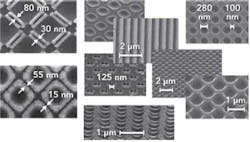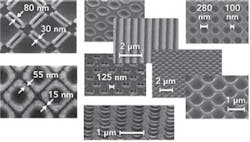Slice and dice: Laser micromachining for consumer electronics
Victor David
More efficient laptop screens, higher capacity flash memory sticks and faster computer processors all result from the replacement of mechanical cutting methods with laser micromachining
Over the past few years, notebook computer battery life has tripled; the capacity of memory cards has increased while their cost has declined; and computers, smart phones, and other digital devices have become ever faster and more powerful. While many factors have contributed to these improvements, the increased use of laser micromachining is a common enabling theme. Consequently, the demand for laser micromachining in the electronics industry has probably never been stronger.
Bright LEDs for long battery life
The use of efficient LEDs instead of inefficient cold cathode lamps as the backlight source in liquid crystal displays has dramatically extended battery lifetime in laptop computers and reduced energy consumption in televisions. As a result, the LED industry is experiencing unprecedented growth.
FIGURE 1. Bright LEDs are created on a thin sapphire wafer and then separated (singulated) by laser scribing followed by physical snapping with a pressure edge.
LEDs used in flat panel displays are based on gallium nitride (GaN), which is grown and patterned as thin (a few microns total) layers on a sapphire wafer. Sapphire is ideal because it provides a lattice match for the GaN and is also transparent. This is important because some of the light escapes the LED by partially passing through the edge of the sapphire substrate. Sapphire is also a fairly good thermal conductor, which helps in heat sinking the LEDs. But unfortunately, sapphire is a notoriously difficult material to cut, second only to diamond.
In practice, LEDs are patterned in bulk on sapphire wafers measuring 2 inches in diameter with a typical thickness of about 100 microns. Thousands of LEDs can be produced on each wafer because the final LED chip may measure only 0.5 mm x 0.5 mm or even less. The LEDs are then physically separated in a process called singulation.
Traditionally, singulation was carried out by scribing (partial cutting) with a diamond saw wheel, followed by physical snapping. But today, most LED manufacturers have switched to laser scribing, again followed by physical snapping using a pressure edge (see FIGURE 1). Here a focused, pulsed UV beam partially cuts through the sapphire. Typically several passes are used to cut through approximately 30% of the wafer thickness (see FIGURE 2). Conventional physical snapping follows.
Laser scribing has become the preferred method for several reasons. First, by focusing the beam down to a spot size of a few microns or less, the laser scribe can be much narrower than a saw cut and with significantly less edge damage (cracking and chipping). This means that LED devices can be packed closer together with narrower gaps, called streets. The high quality edge also eliminates the need for post processing, which is impractical on such tiny devices. All this translates into higher yields and therefore lower unit cost. In addition, tight focusing enables fast scribing at lower laser powers, thus minimizing the cost of implementing lasers.
FIGURE 3. As silicon wafers for memory chips get thinner, the maximum sawing speed gets successively slower. In contrast, maximum speed for laser cutting gets considerably faster.
What laser characteristics does scribing require? The most common laser singulation method is front side (the device side) scribing using a 266 nm, Q-switched DPSS laser. One of the most important laser parameters is beam quality because a low M2 ensures good edge quality and allows minimum LED separation. Basically, M2 is a number that describes how tightly a laser beam can be focused; a perfect Gaussian beam has the theoretical minimum focused spot size defined by M2 = 1. For all real lasers, usually M2 >1. (Many LED manufacturers use the Coherent AVIA 266-3 principally because of its M2 <1.3 rating). Other key laser parameters are reliability, pulse-to-pulse stability, and an average power of at least 2.5 W to achieve target throughput rates. Alternatively, a few manufacturers scribe from the backside of the sapphire using a 355 nm laser; this wavelength produces some minor debris so cutting from the backside keeps this away from the LEDs themselves. Here, beam quality is even more important as sapphire is quite transparent at 355 nm and can only be machined at this wavelength by using a high focused intensity to drive nonlinear absorption. Popular models for this method are either the AVIA 355-5 or 355-7, again because both have an M2 value of <1.3. In addition, a few LED manufacturers are investigating the use of hybrid picosecond lasers such as the Coherent Talisker, where a 532 nm wavelength should produce equivalent results to nanosecond pulses at 266 nm.
FIGURE 4. With so-called low-κ materials, mechanical sawing can cause major damage to the integrated circuits.
More memory in less space
The capacity of SD and microSD memory cards has been steadily increasing over the past several years, yet the physical size and shape of these cards necessarily remains the same. Plus, the unit cost per MB has dropped dramatically. The two primary factors that have enabled this are greater circuit density through advances in microlithography and the use of physically thinner wafers so that more can be vertically stacked together within a given sized package.
At present, typical memory wafer thickness is currently 80 microns or less; 50 microns is considered cutting edge; and 20-micron wafers are being investigated at the R&D level. For economies of scale, these wafers are up to 300 mm in diameter. Since silicon is a crystalline material, a 300 mm x 50 micron wafer is incredibly delicate and easily chipped or broken by mechanical contact. And, with a typical post-process value of well over $100K, breakages must be avoided during the singulation process.
Traditionally, singulation involved multiple passes with a diamond saw wheel. But at 80 microns thickness, the saw must be slowed to an uneconomical rate using low cut pressure to avoid chipping, cracking, and breaks (see FIGURE 3). This has created tremendous opportunities for lasers. Many chip producers have now switched to cutting with a Q-switched 355 nm DPSS laser. Like the saw, laser cutting has to be done in multiple passes to minimize thermal damage, which is removed by subsequent post-processing. For this reason, the single most important laser parameter is a very high pulse repetition rate. Specifically, the typical scan rate is 600 to 750 mm/sec in order to achieve an overall cut rate of about 150 mm/sec with around five passes. Plus, this application needs very good edge quality that requires 50% pulse-to-pulse spatial overlap. Coherent therefore developed a very high repetition rate laser just for this thin wafer application (the AVIA 355-23-250), which combines a 250 kHz pulse rate with power output >8 W to deliver sufficient cutting power per pass. There is also growing interest in process development using hybrid picosecond lasers since the shorter pulse duration produces much less heat affected zone (HAZ), eliminating the need for post-processing.
Faster computers and phone applications
As integrated circuit features shrink, the insulating gaps between circuit interconnects become narrower. Traditionally, the insulating material used in these gaps is silicon oxide. But, higher circuit speeds require lower impedance lines, which means using materials with a lower dielectric constant, i.e., higher resistance. Thus, there is an interest in switching to so-called “low-κ materials,” that is, materials with a lower dielectric constant (denoted κ).
FIGURE 5. Chips using low-κ materials use laser scribing down the street between the chips. The laser scribes act as crack stops enabling high speed sawing with no damage to the circuitry.
Low-κ can be achieved by using traditional silicon oxide, but at lower porosity. In addition, entirely new materials are being considered, again often with increased porosity to increase the air content and thereby further lower their κ value. As with memory chips, these fast processors are created as thin epitaxial layer objects that are densely packed on a large silicon wafer. The problem here with singulation is that low-κ materials are all soft. Thus, traditional diamond sawing can cause considerable damage, including delamination, to the circuits (see FIGURE 4). However, these are thicker wafers than memory devices, so laser sawing is not quite economically practical at this time.
As a result, a hybrid process is now becoming the preferred method. Specifically, a 355 nm, Q-switched DPSS laser is used to cut through the soft epitaxial layers to create crack stops. This is then followed by mechanical sawing through the wafer itself. Two versions are currently used as shown in FIGURE 5. For wafers designed with wide streets between the individual circuits, the laser may be used to make narrow scribes down either edge of each street, in a single pass. With narrower streets, several beams in parallel may be used to make a single scribe that is wide enough to accommodate the saw blade cut. The former is more commonly used as it requires less laser power for a given throughput, i.e. lower processing costs. Key laser parameters here are beam quality and high repetition rate. A typical laser for this application is the AVIA 355-23-250 which provides the requisite 30 microjoules per pulse and M2 < 1.3. Moreover, it can deliver these specifications at a repetition rate of 250 kHz, which supports 200 mm/sec scribe rates with 50% pulse-to-pulse overlap.
Conclusion
In conclusion, the shrinking dimensions of electronic components, together with a shift in materials, continue to make laser scribing an ever-more attractive and economically viable process. Plus, laser manufacturers have worked to improve the performance, reliability, and cost of ownership characteristics of their products to even further broaden the range of tasks for which they are applicable.
Victor David is senior product line manager with Coherent Inc. www.coherent.com.

